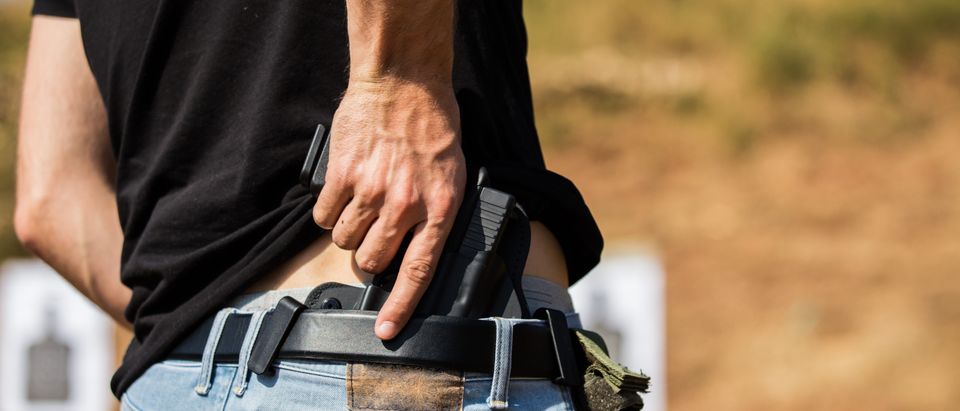By Sam Hoober
One of the tropes that comes up on various forums, message boards and social media is the idea of getting “made” at work or elsewhere while carrying. It’s a fairly common worry or discussion point for relative newbies and experienced carriers alike.
While there is also the talking points about whether it’s worth it to risk your job, it does bring up the idea of merely covering versus actually concealing a firearm.
Webster’s Dictionary defines “concealed” thusly:
- to hide; withdraw or remove from observation; cover or keep from sight
- to keep secret; to prevent or avoid disclosing or divulging
Webster’s defines “cover” thusly:
- to be or serve as covering for; extend over; rest on the surface of
- to place something over or upon, as for protection, concealment or warmth
In the context of concealed carry, rather than cover vs. concealment in terms of shooting positions, the difference effectively means that concealment is when the gun is both covered and not in any way visible, but cover means merely that something has been placed over it.
If you are concealing, the gun and holster are not visible. If you’re merely covering them, they – to some extent – are.
Some people get a little harder-nosed about this than others and for good reasons. If you live in a small town in a constitutional carry state where almost everyone has guns, nobody cares and it’s just not a priority.
So you print a little. So everyone can see your belt clips poking out from your tucked shirt, no big deal!
However, if you live in a large city that has more traditional policies (i.e. permit to carry) then it’s more likely to get noticed. That can lead to some awkward social situations.
If you’re carrying at work, it might get you fired if you get made. We can talk about the right or wrong of employer policies until we’re blue in the face, but none of it matters if you have bills you can’t pay because you’re out of a job.
Reality has to intrude somewhere, and everybody has a different amount of suffering they are willing to endure for their convictions. Some folks are willing to make themselves and their families homeless over not being allowed to carry a gun at work. Others are not.
What we can safely say, then, is that it behooves you to know the difference between merely covering a gun and actually concealing one and that you should be able to do both if you’re going to carry a gun in public as a lawfully armed citizen.
Merely covering a gun is pretty self-explanatory, but what about achieving real concealment?
Here are a few things that you want to avoid if you want to succeed.
Obviously, any printing at all is to be avoided. Holster positioning and clothing choices have to be careful. You shouldn’t have to worry about whether bending forward or reaching overhead will give you away.
Some might think that a tucked shirt means more effective concealment, but not necessarily.
Any obvious belt attachments that will show if your shirt’s tucked is a giveaway that you’re carrying something inside the waistband. This can and has given people away, and has resulted in job loss.
Get on some forums, hit up Reddit (just be careful about what subs you get on, because stuff gets weird in a hurry) and you’ll find people’s stories about it.
While a J- or C-clip can mask the belt clip it will only “conceal” the holster at a glance. Anyone who sees it for more than a second or two will pick up on something being there.
Therein lays another idea as well: the difference between more normal, low-effort concealment (it works up to a point, but wouldn’t pass a serious inspection) and deep concealment, which would keep anyone from discovering you were armed unless frisked.
If you’re truly concerned with concealment, you’ll want to avoid any obvious “gun” clothing. Brands and types of garments that are already associated with gun culture or law enforcement (black polo, cargo pants, desert tan boots, and a thick leather belt? Chances are they have a gun!) should be avoided, as you want to look like everyone else.
Yes, the bad people in society know what 5.11 Tactical looks like.
This is one of the reasons why appendix carry has become so popular in recent years. It lends itself to easier and more maintainable concealment.
However, this gets more complicated as dress codes and uniforms get introduced. Scrubs don’t have belt loops, so you need to have a practicable solution for carrying a gun under them. If you have to wear a tucked shirt for work, a belt holster may not be the best solution or even doable; you may have to switch to pocket carry or a fanny pack, if you can.
Covering a gun is easy. Really concealing one isn’t as simple as it might seem. If concealment is a priority for you, it behooves you to know the difference.
Sam Hoober is a hunter and shooter based in the Inland Northwest.


